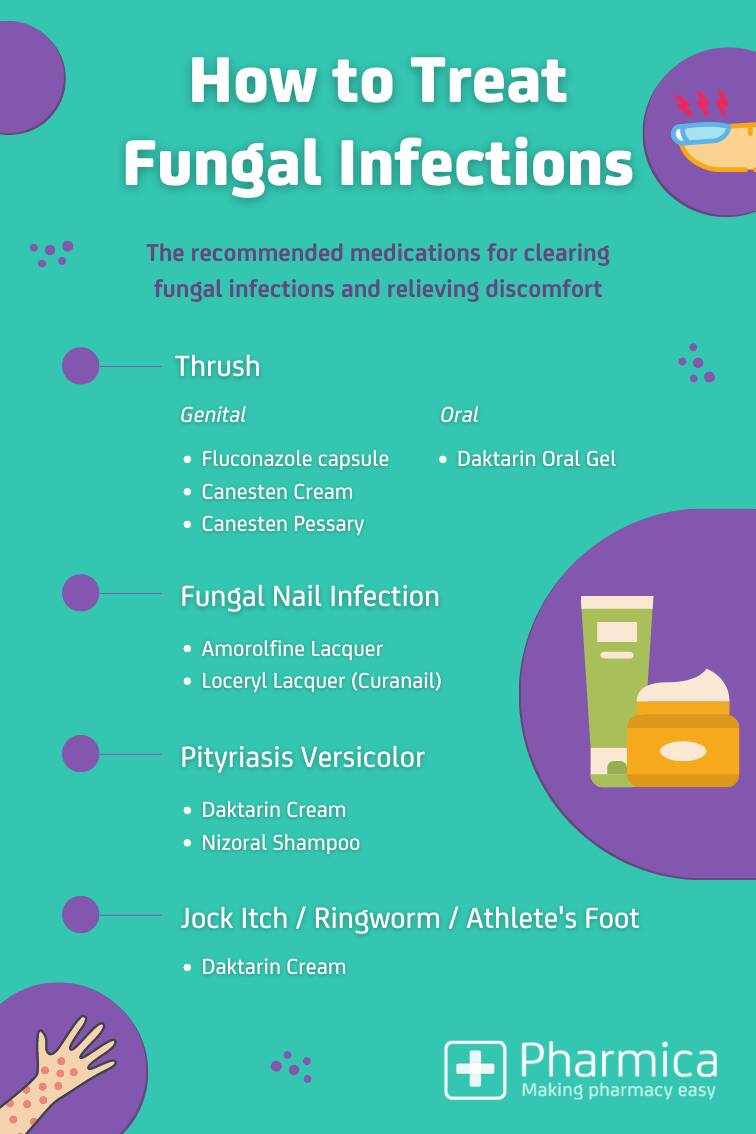
Fungal infections are characterised by an overgrowth of a fungus on a localised area of the body like the skin or nails, often causing symptoms such as reddening or inflamed skin.
Commonly experienced fungal infections are athlete's foot, jock itch, ringworm, fungal nail infections and thrush which often require antifungal treatments to help clear the infection. While these fungal infections are mostly superficial and typically ‘mild’ compared to other more serious fungal infections (such as fungal meningitis), it’s important to know how to best avoid them and how to effectively treat them.

Athlete’s foot
Also known as tinea pedis, athlete’s foot is a fungal infection that usually targets the skin of the feet but can also affect the hands and nails.
Causes
Dermatophytes, the fungi that cause athlete’s foot, thrive in warm, humid and moist conditions, meaning damp socks and shoes can provide a perfect environment for the fungi to grow and overpopulate. Athlete’s foot is a contagious condition that spreads through touch, which means that it can be passed on when coming into contact with an infected person or any uncleaned clothing or bedding that they may have used.
People who are at a higher risk of experiencing athlete’s foot are those who sweat more heavily, those who often share clothing or surfaces with infected individuals or those who use public places that provide optimal conditions for the growth of fungi like saunas, swimming pools or communal showers.
Symptoms
The symptoms of athlete’s foot vary depending on individual circumstances. It can affect either one or both feet, showing as cracked or peeling skin between the toes, itchiness (especially immediately after taking off shoes and socks), burning or stinging sensations as well as blisters and inflammation around the infected areas.
Treatments
An effective treatment for athlete’s foot is the Clotrimazole 1% External Cream, containing the active ingredient clotrimazole, which targets the fungal cells responsible for the infection by destroying their membranes. To administer the external cream, apply a thin layer to the affected area before rubbing it in 2-3 times daily for a minimum of two weeks. You may have to continue the course of Clotrimazole for an additional two weeks depending on the severity of the infection and to stop it from recurring.
When looking at ways to prevent athlete’s foot, there are many daily habits you can try that may prove effective such as allowing your feet to dry out when possible, washing your feet regularly, changing your socks often and wearing waterproof shoes whilst in public pools and showers.
Jock itch
Jock itch, also known as tinea cruris, is a fungal infection that affects the groin area, inner thighs and buttocks. Jock itch is usually caused by the same fungus that causes athlete’s foot and mostly affects men but can also affect women. It’s not usually a serious health condition and can be effectively treated using topical treatments.
Causes
Like other fungal infections caused by dermatophytes, jock itch thrives in warm, damp surroundings. The groin region has a network of apocrine glands that produce sweat, which can get trapped between folds of the skin. If moisture stays trapped between skin without thorough cleaning and drying, the effect of body heat will create an optimal environment for a fungal infection to grow. Wearing tight underwear or trousers, sweating heavily or having a weakened immune system are also risk factors for developing jock itch.
Symptoms
Jock itch usually displays symptoms such as reddened skin around the groin that may be lined with blisters. It may also feel uncomfortable or cause a burning and itchy sensation in the affected area and the skin may begin to peel. Again, jock itch is also a contagious condition so coming into contact with a contaminated surface or person could result in getting the infection.
Treatments
A topical cream like Clotrimazole External 1% Cream can be administered to treat the affected area 2-3 times a day for a minimum of 2 weeks. It may take longer for the infection to clear, in which case it may be necessary to continue treating the infected area for around 4 weeks to prevent the infection from recurring.
Similar to other types of fungal infections, there are plenty of preventative methods you can try everyday to reduce your risk of experiencing a fungal infection like jock itch. Not only do these involve daily bathing and frequent washing and changing of clothes, but also wearing loose-fitting clothing that can increase airflow to the groin to prevent it from staying damp or warm.
Ringworm
Ringworm, despite the name, is not actually caused by a worm. The name is characterised by the ring-shaped rash that appears on the skin after being infected. Ringworm, also known as tinea corporis, can affect the skin on your arms and legs as well as your scalp.
Causes
Ringworm is caused by a fungal infection on the outer layer of the skin and can be easily spread through touch from an infected person, or through shared use of a contaminated material or clothing item. In addition, pets like dogs and cats can also be infected with ringworm, which can be passed to their owners through touch.
Symptoms
The main symptom of ringworm is a red rash on the skin that may present in the shape of a ring with a darker red outline. The rash may be itchy and over time could become scaly and flaky, possibly feeling tender or sore to the touch. Another symptom is the growth of blisters around the site of infection. If the infection is localised to the scalp, you may experience minor balding at the point of infection.
Treatments
Ringworm can be successfully treated with a topical antifungal cream like Canesten 1% External Cream that can also be used to treat ringworm and provide relief from its symptoms when administered to the affected area, as it contains the active ingredient clotrimazole for targeting fungal cell membranes, halting the growth of the infection.
Avoid sharing towels, clothing or bedding with someone who has a fungal infection and maintain a good level of personal hygiene to reduce your chances of developing ringworm.
Fungal Nail Infection
Onychomycosis, also known as tinea unguium, is a fungal infection that affects the nails of the hands and toes. It is more common to experience a fungal nail infection on your toenails, as wearing shoes and socks traps warm air and moisture, creating perfect conditions for fungi to thrive and overpopulate.
Causes
Like other fungal infections caused by dermatophytes, fungal nail infections have a greater chance of growing in a warm and moist environment, which allows it to grow in excess. If you regularly have your nails wet, there is a greater chance that you will experience a fungal infection.
Symptoms
One of the most common symptoms of fungal nail infections is a change in the appearance of the nails. This includes discolouration of the nail, thickening of the nail itself, pain or irritation around the infected nail, and the nail becoming brittle and possibly breaking.
Treatments
Amorolfine Medicated Nail Lacquer 5% or Curanail (also known as Loceryl) are effective antifungal treatments for nail infections on the fingers and toes. The active ingredient, amorolfine hydrochloride, stops the spread of infection by causing holes to appear in the fungal cell membranes. To treat the infected nails, apply the lacquer using an applicator once a week and keep using it until the infection has cleared and your nail appears healthy. This usually takes around 6 months for fingernails and 9-12 months for toenails but ensure that you consistently treat the infected nail every week without breaks to prevent the infection from returning.
When treating a fungal nail infection, it is recommended that you keep your nails well trimmed. Try to avoid picking the skin around the nails and make sure to dry your fingers and toes thoroughly after washing your hands or feet. You can reduce your risk of developing a fungal nail infection further by avoiding going barefoot in public places that offer optimal environments for fungal spores like public swimming pools, baths and gyms. Gloves can be used in situations where your hands are frequently wet.
Other Forms of Fungal Infection:
Thrush is another form of fungal infection, caused by an overgrowth of the candida fungus. The most common form is genital thrush, which affects the skin around the penis or vagina. Another form is oral thrush, which affects fewer people; typically babies, the elderly, or the immunocompromised. However, both can be effectively treated with our range of genital thrush treatments and oral thrush treatments.
Whilst they can cause unpleasant symptoms, fungal infections are generally easy to treat, and there’s a range of different treatment options to choose from. Make sure to follow the prevention advice given and keep to a good standard of hygiene to reduce your risk of developing a fungal infection.